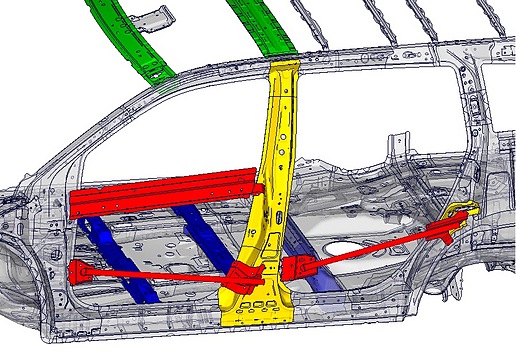Toyota might have been trailing several competitors in meeting the little offset barrier test set by the Insurance Institute for Highway Safety (IIHS). Although with the new Highlander, it’s taken its safety engineering to IIHS’s highest rating, Top Safety Pick . The Highlander becomes the 1st 2014 model in the mid-size SUV/crossover class to receive it.
The “plus” rating requires Good ratings in four crash tests: moderate overlap front, roof strength, side, head restraint, and a Good or Acceptable rating from the small overlap front. The tiny overlap test was introduced in 2012 to replicate the left front corner of a vehicle hitting a tree, utility pole, or any other car at 40 mph (64 km/h). Highlander was rated Acceptable.
Crash avoidance/mitigation is the “plus” factor and is based on a front collision warning and automatic braking systems to prevent or mitigate the effects of a impending accident. Highlander got an Advanced rating for its optional system.
Body beefed up in front and side, rear
Toyota took many steps in body/frame construction to pass the crash testing, and after that went beyond. The left front has a spacer at the bumper, which absorbs and transmits impact energy that’s outside of the bumper reinforcement in to the front side member. From that point it flows into a joining plate with the reinforced front A-pillar area, from which it is actually distributed up into the roof side structure and down through a rocker panel joining plate in to the lower body side structure.
Much of the Highlander forward side structure is made with high-strength steel, with ultra-high-strength steel inserts employed in the rocker panel and (as is customary) the B-pillar. The distribution of crash energy through the two joining plates as well as the beefed-up body structure suppresses body deformation around the cabin from a frontal collision, Toyota said. The two joining plates also are suited for the right side.
Side-impact protection includes door impact beams of course, and both the roof structure and floorpan have reinforcing crossmembers that transmit loads towards the opposite side in a side-impact collision.
The back has a collision mitigation design in the form of straight side members and three floorpan crossmembers forward from the rear bumper. The engine compartment hood features a pedestrian protection design–an inner panel that is certainly longitudinally ribbed to provide a crush space above the engine for the pedestrian landing on the outer skin of the hood.
Pre-collision warning, auto braking
The front side pre-collision system uses a millimeter-wave radar sensor, a type that is preferred for its image resolution and ability to identify what it “sees” ahead (car, pedestrian, etc.), even at nighttime. It also provides usable readings through rain, fog and dust and smoke. The Highlander’s driving support module is the primary sensor signal collector/processor and its skid control (stability control) module may be the electronic “foreman” for the system. The system uses signals in the steering, road speed, and yaw sensors.
It transmits a signal for an instrument panel warning display to flash and a buzzer to sound if the driving support module decides a collision can be done or likely. It also asks the skid control module to switch the brake assist to a readiness state. In case the driver’s foot hits the brake pedal enough to trigger the brake lights, the brake assist is activated. This part of the system comes into play at road speeds of 19 mph (30 km/h) and above.
Automatic braking is commanded if the driver doesn’t apply the brakes, with a collision possible or likely, a closing speed of 10 mph (15 km/h) or greater, and when reducing engine power wouldn’t provide enough deceleration. The skid control module applies the brakes through the anti-lock brakes hydraulic actuator. And additional braking is needed to further mitigate the crash, it sounds the buzzer to the driver to utilize the brakes, if the module determines that the won’t prevent a collision.
During automatic braking, the driving support module sets a target deceleration rate and continuously recalculates it. If the automatic braking does eliminate the collision danger, the system reduces the automatic application for smooth deceleration and returns to manual braking.
The new Prius also got a “plus” rating, although with Toyota’s competitors having moved quickly to accomplish it too on some vehicles (apart from mid-size SUVs), and a total of 22 vehicles already listed, it’s become the “need to have” for new models.


